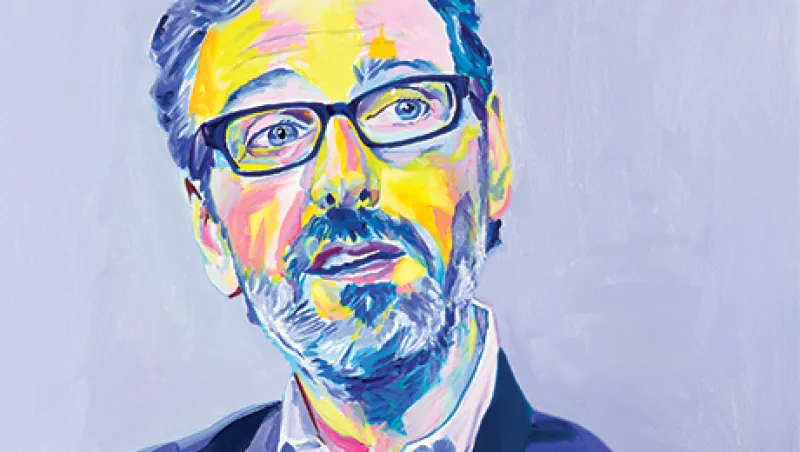I should have known this would happen.
I sent Mark Carhart an email proposing two options for an interview: Either we take a bike ride together, or watch one stage of the Tour De France, the three-week bike race that takes place every July. (The 51-year-old Carhart, founder and CIO of New York–based quantitative alternative investment firm Kepos Capital, is something of a cycling evangelist.) He wrote back immediately, enthusiasm radiating off the screen. “A bike ride sounds great. Shall we do a Citi Bike ride? If you’re game, I could do tomorrow, or Thursday this week or Monday next week.”
The Carharts live on the Upper East Side. Every morning that he can, Carhart drops his girls off at their school (he and his wife have four daughters). Then he picks up a Citi Bike — the for-hire bikes available around New York in a program sponsored by Citibank — and rides to Kepos’s offices at 41st Street and 8th Avenue, commuting through Central Park.
Although a fan of competitive cycling, I’m not much of an urban bike rider — certainly not one keen on taking on Manhattan’s traffic. But I assure myself that a ride through Central Park is not overly daunting. Thus a Monday morning in late June finds me apprehensively waiting for Carhart at a coffee shop on 5th Avenue between 89th and 90th. Then my phone pings.
It’s Carhart.
“If you can get a bike, keep it. Looks like stocks are low on the Upper East Side.” He’s right: There are no functioning bikes in the stands anywhere near this entrance to the park. I’m ready to give up and settle for coffee. But no: “Looks like the nearest station with bikes is at Madison and 99th,” he says, apparently consulting his bike-sharing app. “Shall we meet there?”
We do, and we begin.
To spend any time with Wall Street and hedge fund cyclists and biking fans is to know that many of them can be giant, spandex-clad assholes — the type of people who look down on anyone who has not climbed Mont Ventoux (a famous mountain in France, often one of the most iconic stages of the Tour de France) and for whom the idea of a Sunday afternoon bike ride means putting the “endure” in endurance sports. Not Carhart. Yes, he has ridden with pros, and yes, he owns some spandex, but he also bikes with blind people.
In 2013, Carhart started InTandem. The not-for-profit allows the visually impaired and the disabled to enjoy the thrill of bike riding, hosting regular bike rides in Central Park where disabled bike riders ride in tandem with able-bodied riders.
Once we leave behind the hellscape that is New York City traffic and enter the bucolic roads of Central Park, I am able to concentrate on something other than certain death. I ask Carhart how InTandem is going. “It’s great!” he says. “We have our big annual fundraiser coming up.” The fundraiser is a midnight tandem bike ride through the five boroughs of New York, stopping to get a donut at the “best” donut shop in each borough.
Carhart founded InTandem with Artie Elefant. “Artie was a real mentor to me,” Carhart says sadly. Elfant, who had lost his sight to retinal pigmentosa, passed away in 2013, the same year InTandem came into being. Another mentor in life and in cycling was Kent Daniel, Carhart’s former professor at the University of Chicago’s Booth School of Business, where Carhart received his Ph.D. in 1995. “I remember going by his office and seeing that he had a Colnago bike there, and thinking that was so cool.” The two started biking together.
Carhart says he uses riding as a way to clear his mind: “I typically have a thousand things going through my head.” And though bike riding can be social, he also appreciates the isolation. Having grown up in Washington state, Carhart earned his MBA from Yale University in 1988 before heading to Chicago, where he was surrounded by quants. Cliff Asness, who received his Ph.D. from Booth a year before Carhart, had gone to Goldman, Sachs & Co. to run Goldman Sachs Asset Management quant fund Global Alpha. Asness quickly hired his classmate John Lew, and Carhart and another Booth Ph.D. student, Ray Iwanowski, followed shortly after. When Asness and Lew left in 1998 to form their own firm, AQR Capital Management, Carhart and Iwanowski took over Global Alpha. They remained at the helm for more than a decade.
Global Alpha experienced some highs and lows between 1998 and 2008, at one point growing to be the largest hedge fund in the world. It also sustained significant losses in 2006 and 2007. It was during one of Global Alpha’s down years that I first got to know Carhart. I was seated next to him at a dinner where he very patiently endured my (ill-informed) critique of where the hedge fund had gone wrong.
After cycling and family, Carhart’s other big passion is still quantitative investing. At GSAM, the Global Alpha group applied the research of Booth professors Eugene Fama and Kenneth French to the challenge of not just picking stocks, but investing in asset classes. Carhart, who before joining GSAM had been an assistant professor at the University of Southern California’s Marshall School of Business and a senior fellow at the University of Pennsylvania’sWharton School, is a big believer in factor investing. “I think all institutions will start investing this way,” he says. “It just makes so much more sense.”
Carhart and Iwanowski both retired from GSAM in 2009. Carhart founded Kepos in 2010. Today the firm, which offers both alpha and beta quantitative funds with strategies applied across markets, has a little more than $3 billion in assets under management. Kepos’s has been a slow and steady build — mostly in the face of strong hedge fund headwinds.
Carhart and I often discuss the ups and downs of the hedge fund industry — in between bouts of discussion about cycling. Who does he think will win the Tour de France this year? “It’s a wide open race, but Porte has the form,” he says, referring to Australian rider Riche Porte.
It’s time to wrap up our own bike ride. Carhart says goodbye near my subway stop, then rides on toward his offices.
My bike-handling skills might be lacking, but I’m not a complete lost cause. At time of writing, five days into the race, I am leading the Kepos Capital Tour de France fantasy league. (No surprise that many, if not all, Kepos employees are cycling devotees.) Carhart’s chances were blown after one of his picks, the gutsy Spaniard Alejandro Valverde, crashed out on the first day. Carhart’s inside pick for Tour winner, Porte, was also forced to abandon the race after a horrific crash in which he broke his collarbone and pelvis.
Fortunately, a quantitative manager requires a very different skill set than that used to handicap cyclists in a three-week race. Vive la France!






